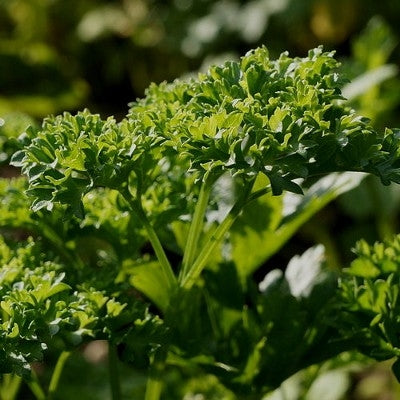CURLY PARSLEY GRÜNE PERLE - kr30
Have a question?

CURLY PARSLEY GRÜNE PERLE - kr30
Dettagli
Scientific name: Petroselinum sativum
Family: Umbelliferae
Brief history and botanical notes on the plant
Already known and used as a food-medicine by the Greeks who planted it together with rue at the edges of the flowerbeds, it was used to crown the winners of the games and to decorate the tombs. Even the Romans made extensive use of it in the kitchen as an antiseptic.
Very widespread in cultivation, often growing wild, even sporadically spontaneous in Italy from the sea to the sub-mountain plain.
Parsley is a biennial plant of the umbelliferae family, with large roots and erect stems that reach 50 cm in height; It has thin stems from which bright green, fragrant leaves with jagged edges branch out.
Parsley flowers in the second year of cultivation, the flowers are umbelliferous inflorescences made up of small green-yellow flowers.

Pedoclimatic needs
Moderately resistant to the cold, it however prefers a temperate climate with mild and short-lived winters. Vegeta with temperatures above 6°C, cannot tolerate temperatures above 35°C.
Sowing and transplanting times
It is sown in the field from spring to June, in northern Italy; if the temperature is low it germinates slowly, at optimal temperatures (18° C) it takes about fifteen days. To encourage germination, it is useful to place the seeds in warm water overnight before sowing.
The sowing is carried out by broadcasting, then the excess seedlings are thinned out in order to obtain a distance between the rows of 25 cm, on the row of 5 cm.
Following the lunar calendar, the best period for sowing is represented by the 48 hours following the full moon.
Processing
It has no particular needs even if it prefers fertile medium-textured soils. It is important to keep the soil clean from weeds and hoe and weed to facilitate irrigation and aeration of the plant.
Fertilizations
Parsley requires soil with a good supply of organic substance (well-mature manure or compost) at a rate of 3-4 kg per m2, which must be buried before sowing; it is very demanding regarding phosphorus.
Products
There are no specific products for fertilization or defense.
Crop care and irrigation
Parsley germinates slowly, so the control and elimination of weeds is essential. Constant irrigation is also essential to encourage the development of the plants.
Adversity
Parsley can be attacked by various insects, among which the most harmful are the beetle and weevil larvae which eat the roots up to the collar.
Among the cryptogamic diseases we remember septoria, which manifests itself with yellowish spots with a dark outline on the leaves and later on the stems with blackish spots; Cercospora is also very frequent, and is highlighted with amber-coloured dots.
It is necessary to adopt good agronomic practices, avoiding excessive nitrogen fertilization and too frequent irrigation, in particular overhead irrigation should be banned.
Defense products
Always use controlled seeds and carry out the correct crop rotations (never cultivate after other Umbelliferae) are the first guarantees for obtaining a healthy and good quality harvest.
Only in the case of particularly rainy years is it necessary to resort to treatments with copper-based products.
Production and collection
The harvest takes place 70-80 days after sowing; it is better to remove the entire plant up to 1-2 cm from the ground to encourage growth for subsequent cuts. It is a fast growing plant so, once cut, it immediately throws out new stems.
Roots harvested at the end of the season in autumn can also be used; they can be dried and stored in glass jars.
From one square meter you can harvest 2 to 3 kg of parsley.
Nutritional values
100 g of parsley contain (36 kcal): 87.1 g of water, 2.9 g of proteins, 0.7 g of fat, 6.4 g of carbohydrates, 3.3 g of fibre; it also contains good quantities of calcium, potassium, sodium, zinc, phosphorus and magnesium. It is particularly rich in vitamins A, C and K.
The medicinal properties of parsley are due to the presence of an essence consisting of apiol, apioside and myristicin.
Considering its components, parsley is used as a diuretic, purifier (the roots), emmenagogue (the seeds), antiseptic and antispasmodic.
Parsley is used as a decoction, infusion or juice for purifying purposes, taking care not to exceed it as it is toxic at high doses; leaf poultices are used for bruises and insect bites; the juice of the leaves is used to lighten freckles.
Family and variety
It belongs to the Umbelliferae family (like carrot and fennel); among the most widespread varieties are the Gigante d'Italia, the Common Parsley and the Riccio.
Biodynamics
Distribute the preparation 500 in the evening, before the main processing and weeding on soil or water days; distribute the 501 preparation at least 50 days after the emergency by carrying out the treatments early in the morning, on sunny days and on days of air or fire to improve resistance to diseases.
Using the biodynamic calendar:
To reduce the germination period, you can keep the seeds in a fabric moistened with the preparation 500 for 24-48 hours, then proceed with sowing without allowing the seed to dry out too much.
Parsley is considered a leafy plant; carry out sowing on the new moon, always choosing warm days, also for thinning and harvesting, to favor the formation of the aroma and organoleptic qualities.


